There are four main abdominal muscles which include the Rectus Abdominus (six-pack), the External and Internal Obliques located on each side of the stomach and the deep Transverse Abdominus muscle. An abdominal strain is therefore a tear in the fibres that make up any of the four abdominal muscles. Luckily abdominal muscle strains are rare but if they do occur, Physiotherapy is very important to avoid a re-occurrence.
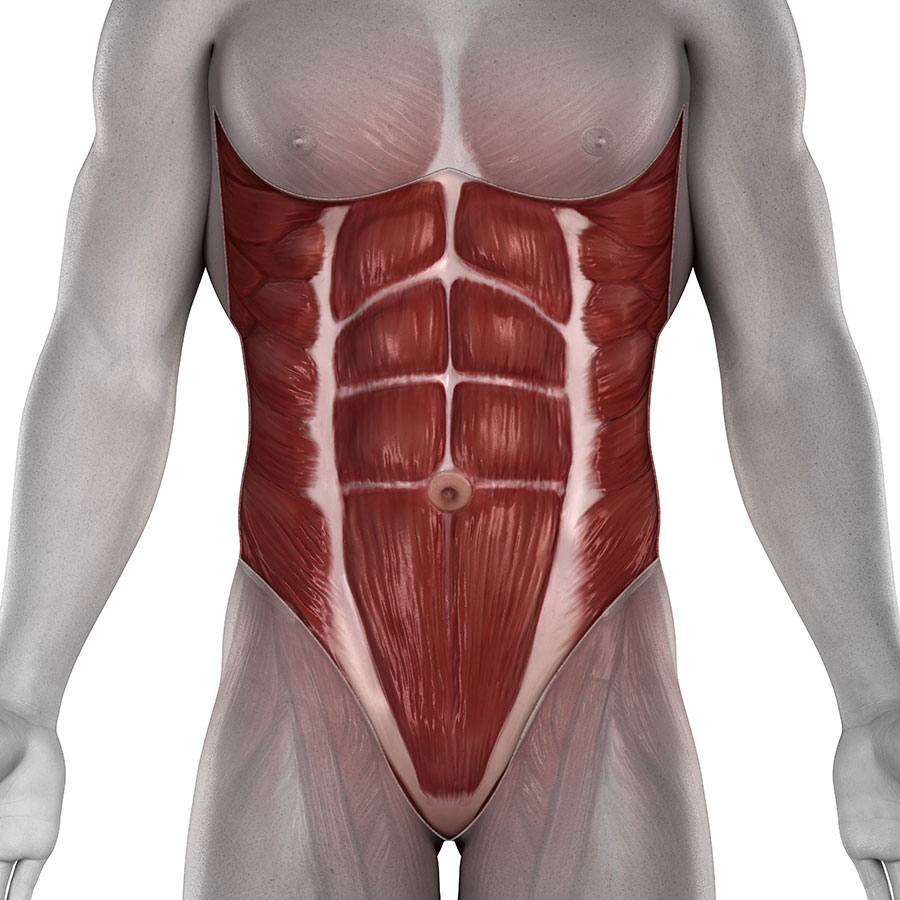
The Abdominals
The 3 flat belly muscles
As stated above, the abdominals are 4 different muscles. The deepest layer is the Transverse Abdominus (TA). This muscle is often referred to in Pilates. It basically wraps around the whole body, starting from a thick fascial part in the back and the edge of the pelvis as well as from the bottom ribs and attaches to the line in the front of the stomach, the little point at the bottom of your chest bone and the bottom of the pelvis.
Just above the TA is the Internal Oblique muscle. It comes from and attaches closely to the same areas as the TA does, although it looks more like a fan from the length of the top of the pelvis fanning up to the bottom ribs.
The External Oblique lies just above the Internal Oblique. So we are on layer three now. It is the last of the three flat belly muscles that we have. It runs across the fibres of the Internal Qblique, meaning that it comes from the outside of the ribcage and attaches to the middle line of the stomach. The direction of its fibres is from the top (rib cage) obliquely downwards. Do you see where the obliques get their name?
The Rectus Abdominus
Lastly we come to our six pack muscle. In ladies we should refer to it as a four pack muscle. It is very possible for ladies to also attain a 6 pack, but not necessarily as healthy as it is natural for men. Nevertheless it looks exactly the same in men and women. ‘Rectus’ comes from the Latin word meaning “straight” and abdominus just refers to the abdomen. The bottom of the pubis is the location where it comes from. It then runs straight upwards, being intersected by 3-4 tendinous lines. These give it the washboard look. Finally it inserts into ribs 5-7 and the bottom of your chest bone, called the Xyphoid process.
What action exactly do the abdominals do?
As there are different muscles that form the Abdominals, there are also different actions that the muscles do. They all help in creating intra-abdominal pressure, which we need when coughing or sneezing and they help when going to the toilet to urinate.
Starting with the TA (Transverse Abdominus) it is mostly there to support your posture. It is your internal brace that stabilises your spine and pelvis in any and every position. Your internal organs are also kept in place by this muscle. Otherwise, they would spill out like beans (excuse the visuals).
By acting as a brace or corset, it has a lot to do with the pressure build-up in your core.
Intra-abdominal Pressure
I want to compare the intra-abdominal pressure to the pressure of a coke can. If you try to stand on a full coke can it will be impossible to crush the can with your body weight, no matter your weight. As soon as you open the can though, you will very easily crush it under the weight of your foot.
The same pressure that is in the coke can is built up in our core when we are trying to lift something substantial. If you do not build up that pressure your spine is very susceptible to get injured (“being crushed”).
The 3 action muscles
The Internal and External Oblique muscle flexes the trunk by helping to pull the ribs closer to the hips. In addition to that, when acting only on the one side, they rotate the opposite shoulder down and bends the body to the side. Blowing out candles would also not be possible without the Internal Oblique muscle, as it assists forced expiration. In connection with that, it helps to push out a baby as well during childbirth.
The Rectus abdominus is there for flexion purely. It is there to help you do sit-ups, crunches and a variety of abdominal muscle training focusing on this muscle to attain a 6 pack in the long and consistent run.
Is the core the same thing as the abdominals?
The Core
….is so much more than only the abdominal muscles. It involves more muscles than only the abdominals, yet the Rectus Abdominus is not really part of the core, strictly spoken.
The most important muscles that also form part of the core are the diaphragm (breathing muscle), the multifidus (small stability muscles in the back) and the pelvic floor (deep muscles in the pelvis). The core mostly works as a stabiliser or it transfers energy/ force from the lower to the upper limb or vice versa. It is responsible for controlling the force of our body that we produce. A lot of people are powerful but cannot control their strength. Inability to direct power is where the correct core training is essential. Your uncontrolled strength can be the cause of injuries.
Do not confuse your core training with abdominal training. It is completely different.
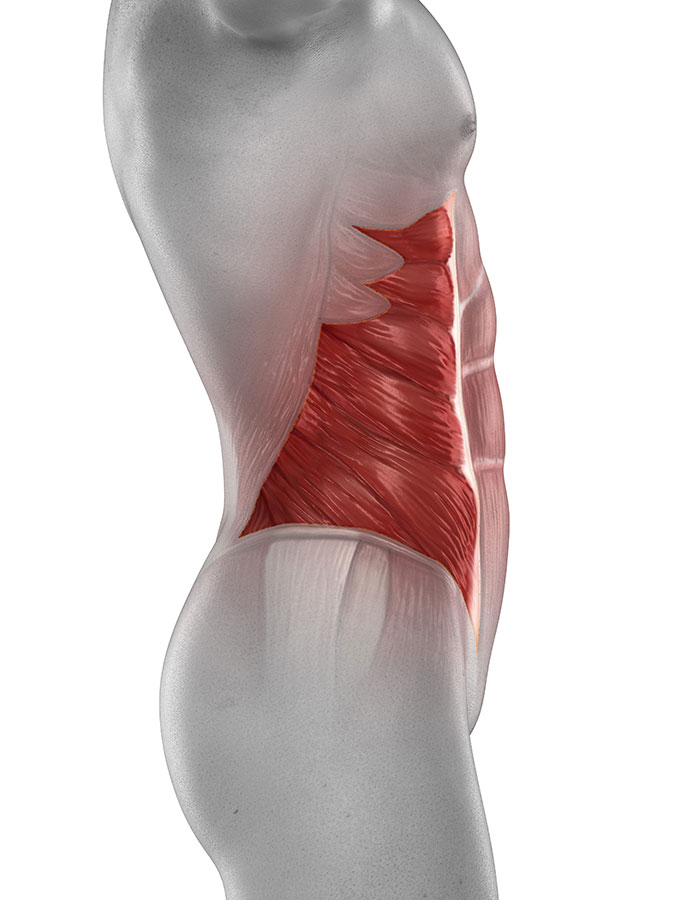
How does an abdominal strain occur?
An abdominal strain can occur from exercises such as sit-ups or during a strong twisting movement. Abdominal strains can also occur during heavy bouts of coughing or sneezing which will place added pressure on the abdominal muscles.
Sports physicians reckon that a Rectus Abdominus tear is most commonly found in Tennis players. In Tennis, Cricket, Baseball or any asymmetric sports you will often get unilateral tears. A unilateral tear means that only the one side of the stomach will get a tear. Mostly this is on the opposite side of your dominant hand as a result of a repetitive powerful action like the serve or bowling. The force always has to be generated by the trunk being pulled down into a flexed position. Overusing and straining the muscle over its capability will tear it.
Internal and External Oblique muscle tears are rather uncommon. In any ball sports, their action is to help decelerate the trunk after the impact of a ball. Mostly they will appear on a forceful twisting movement where pain will be felt immediately afterwards. For instance, on a single backhand shot or a highly loaded Russian Twist at Gym.
There are different grades of abdominal strains depending on the severity of the injury:
- First – Grade 1: a limited number of muscle fibres are torn
- Second – Grade 2: a greater number of fibres are torn with more pain and bruising
- Third – Grade 3: a complete rupture of the abdominal muscles (very uncommon with non-traumatic injuries)
What are the symptoms of an abdominal strain?
The main symptom of an abdominal strain is pain which varies in severity depending on which grade is experienced. It may also be sore to touch the area and local inflammation may be evident. With more severe strains, there could be bleeding in the tissues causing bruising. It will be difficult to carry out any movements that involve the abdominal muscles which includes sitting up, twisting and standing for long periods. Other symptoms include:
- pain on resisted twisting movements
- pain on a deep inhalation
- swelling/inflamation/ blueness
- stiffness
- weakness when bowling or serving
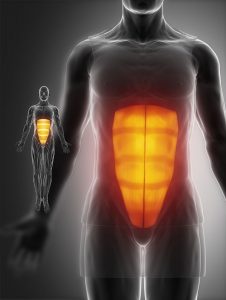
Diagnosis and self-tests
A positive test is when you have pain performing the prescribed movement:
- sit-up
- lifting a heavy box from high to low surface, while rotating the trunk
- throwing a ball in serve or bowling action
- performing a pull up
- simply stretching to the full extent in the morning, lengthening the stomach area
Diagnosis
We will test the
- muscles with specific tests
- the nerves that might be affected
- the spine and pelvis
- ask questions to exclude internal organ dysfunction or problems
- discuss and evaluate your bio-mechanics that might be faulty
What should I do if I have an abdominal strain?
If you suspect you may have an abdominal strain, it is important to see a physiotherapist as soon as possible. It will be useful to apply some crushed ice wrapped in a damp towel to the area to reduce some of the inflammation and pain. Any anti-inflammatory medication should not be taken within the first 24-48 hours in most cases. Remember that inflammation is the natural reaction of your body to try and heal something that was injured.
Discontinue the sport or movements that cause you pain and rest. Physiotherapy can assist you with pain control, the right advice for your specific situation and to minimize the healing time. Rehabilitative exercises should only be started at day 5, with the correct exercises, advancing systematically. Refer to the bottom of the article for the stages of rehabilitation.
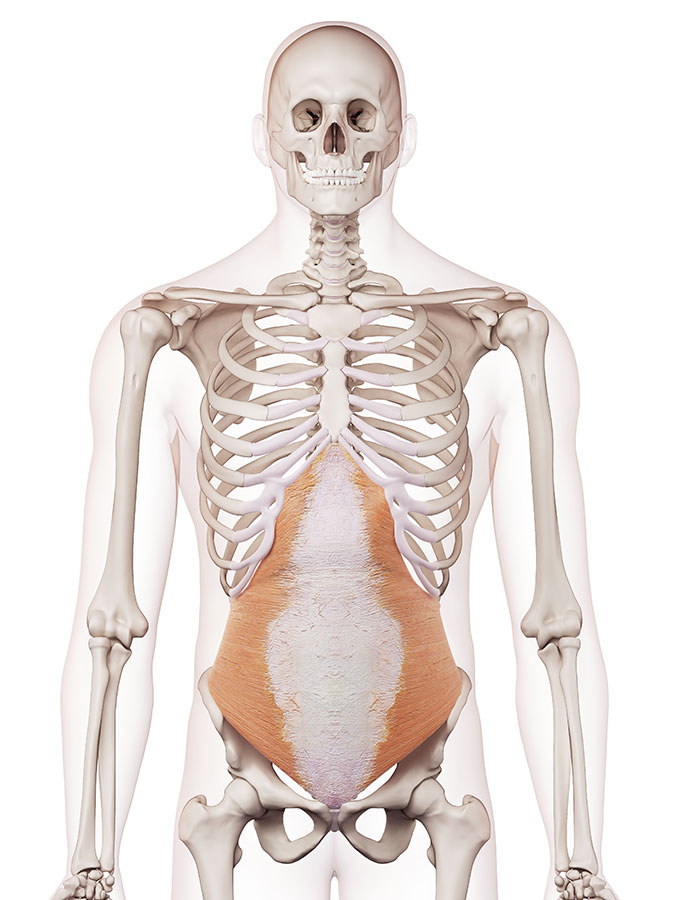
Physiotherapy treatment for an abdominal strain.
There are many physiotherapy options to treat abdominal strains including cyrotherapy (ice), electrotherapy techniques such as ultrasound and a graduated exercise programme. Other treatments may include:
- Hydrotherapy
- Soft Tissue Treatment
- Postural Realignment
- Core Stability Exercises
- optimizing the bio-mechanics of your specific sport
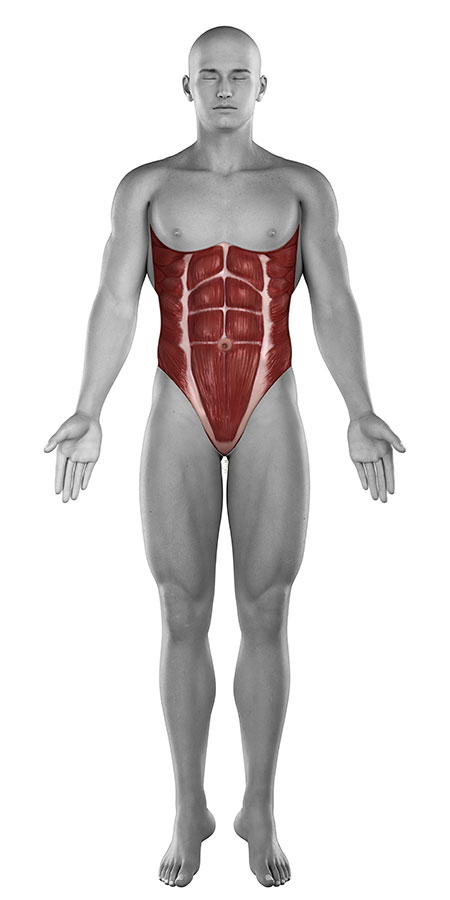
Phases of Rehab
1. Control of pain and inflammation, protection
Rest is the most important part of this stage of rehabilitation. You do not want to aggrevate your injury and lengthen the period of time to recover by making things worse by carrying on with movements that create more damage.
Make sure to be evaluated properly to determine the severity of your injury.
2. Isometric strengthening and stretching
Using the muscle itself with no movement is started. Lying on the back with your knees bent you will start to “activate” the stomach muscles. No movement should appear. Light stretching should also start in this phase.
3. Concentric strengthening
Exercises to strengthen your muscles will start in this stage of Rehab. Your sport specific movements can start again, still avoiding movements that could hinder the healing that is taking place. You should focus on the other kinetic chain links. These are the shoulder and the legs. Keep them in good condition while continuing with the full Rehabilitation process of your abdominal strain.
4. Eccentric strengthening and plyometrics
Faster movements need to be integrated now. These movements need to be progressed slowly with weight or speed. It is very important to address the bio-mechanical action that also caused the injury. Often a movement can be optimized to reduce the risk of a re-injury. In this phase you should return to competing in your specific sport again.
5. Maintenance and re-injury prevention
Do not stop with the specific exercises your Physiotherapist prescribed. You still need to keep strengthening for at least 1-2 months after you have returned to your sport.
What shouldn’t I do if I have an abdominal strain?
If you think you may have an abdominal strain, it is important not to continue with any of the activities that aggravate your symptoms. Do not ignore your symptoms as this may make your injury worse and more difficult to recover from.
Could there be any long-term effects from an abdominal strain?
Grades one and two abdominal strains usually resolve effectively with a physiotherapy program and rest from aggravating activities. A grade three rupture may require surgical intervention but it is still important to begin physiotherapy before and after the operation to optimise your recovery.
If an abdominal strain is not addressed adequately, it might return again and again. It is very demotivating for any sports person to struggle with the same or similar injury and often the sport is then stopped completely or there is always fear in the back of the mind to hurt yourself again.
Medical management
Very rarely is an abdominal strain operated on. The tear must be a grade 3 tear to even consider surgery.
The medical management can be assisted with anti-inflammatories after the first 24 hourse have passed. Beside that a brace is an option to remind you not to move excessively in the resting phase of the rehabilitation, although this is often done with strapping or taping by your Physiotherapist.
What else could the pain be?
- IBD = inflammatory bowel disease
- IBS = irritable bowel syndrome
- PID = pelvic inflammatory disease
- Abdominal Hernia
- thoracic nerve entrapment
(Anterior cutaneous nerve entrapment syndrome) - hip flexor strain

